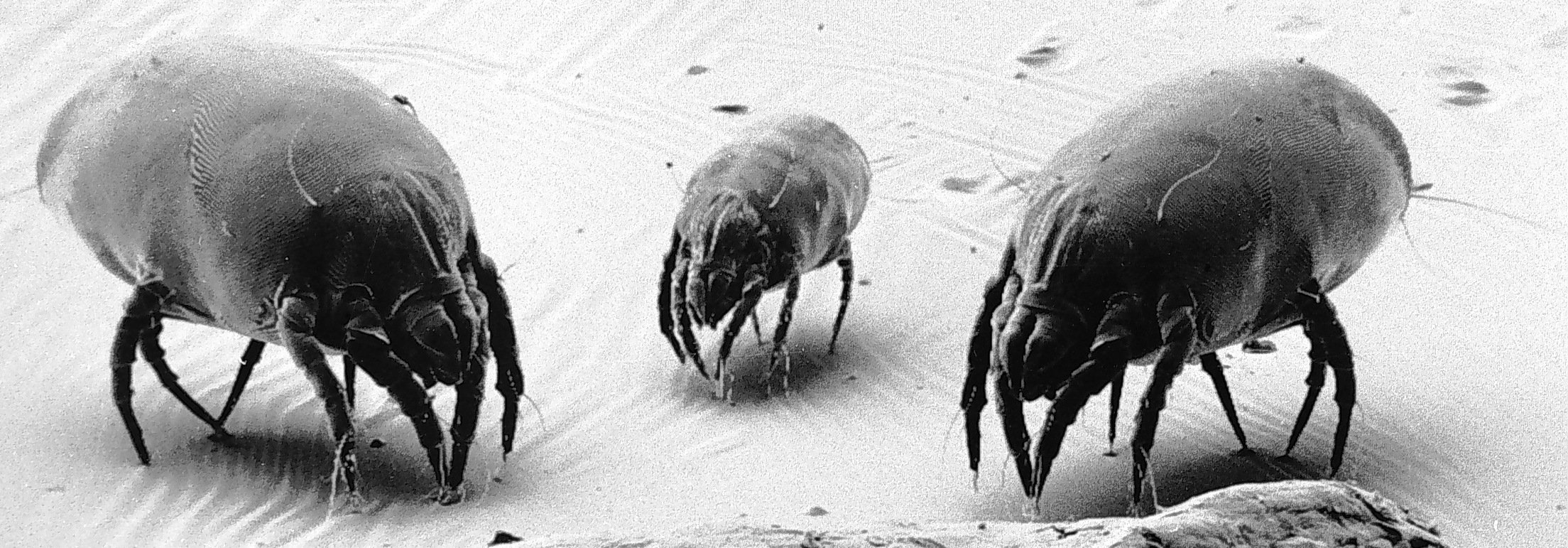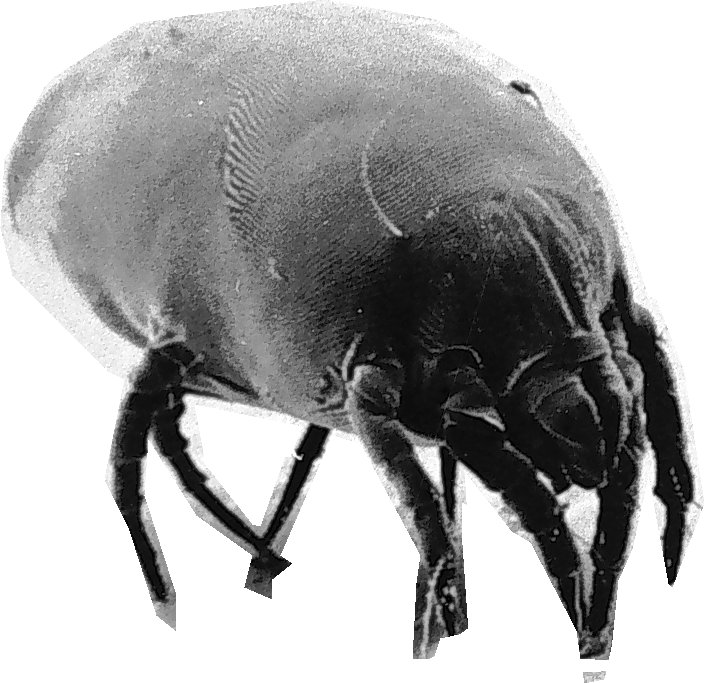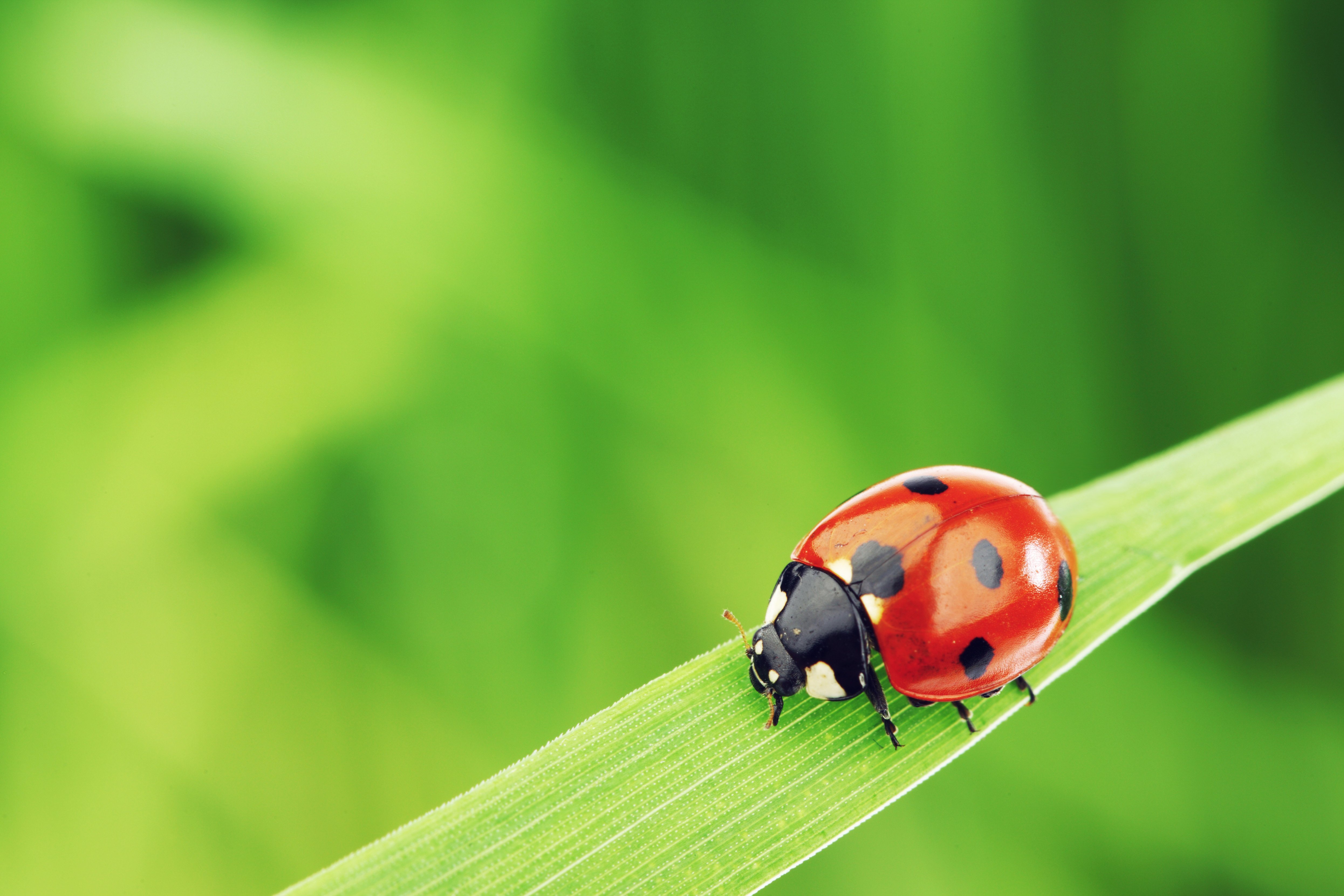


Evolution Biotechnologies is developing its novel, environmentally friendly approach to control house dust mites and the powerful allergens that they release
Dust mites infest our homes and are a key cause of and trigger for asthma and a range of allergies
Based on multiple awarded patents and an established technology platform, the Evolution approach provides a natural solution for asthma and other allergies that affect billions of people around the world
GREEN, UNIQUELY EFFECTIVE - BIOLOGICAL CONTROL
Evolution Biotechnologies Ltd. is a British company working to expand biological control from its successful applications in agriculture, bringing this highly specific and environmentally friendly technology to the control of medically important targets.
This starts with asthma, a chronic disease affecting over a quarter of a billion people around the world, and a range of other allergic conditions - all with a common cause: the powerful allergens produced by the millions of the house dust mites that infest our homes.

Evolution's initial target is the house dust mite (HDM), a key cause of asthma and a range of other allergies worldwide.
According to the World Health Organisation, 262 million people worldwide suffer from asthma, of whom approximately 20% require frequent hospitalization. 455,000 people every year die as a result of asthma. Up to 90% of asthmatics who react to airborne material are sensitive to the powerful allergens produced by the house dust mite.
The costs of asthma exceed $100 billion in the EU and US alone. Othe allergies add to this.
Biological control is a proven technology with wide applications in agriculture, and extending this to benefit human health underlies Evolution's approach. It is environmentally friendly, using natural agents. These are highly specific, reducing any side effects or environmental concerns. They are applied in small doses and spread naturally, producing long-lasting effects.
Operating from its base at Colworth Science Park in the United Kingdom, the company is addressing worldwide unmet medical needs, with projected markets for its initial product exceeding $3 billion per annum.
These markets are secured by patents deriving from PCT filing WO2017025732A1 "ACARICIDES" that are awarded in multiple jurisdictions around the world.
Aeris Biotechnologies of Dallas, Texas has taken a licence to the Evolution patents and is working with the company to develop its unique technology.
Click on the link below to visit the Aeris website:

Dr. David Harper, UK: Chief Executive Office and Chief Scientific Officer

Mr. Aaron Gunn, USA: Chief Operating Officer
ASTHMA AND ALLERGIES

Asthma and allergic diseases are lifelong conditions resulting in widespread ill health, with high levels of unmet medical need.
The changes in lifestyle that come with higher income carry with them increased risk of a range of diseases. Obesity and cardiac disease from excessive food intake, cancers from extended lifespans and exposure to carcinogenic agents, and asthma and a range of allergies, with a key cause and trigger being exposure to the potent allergens produced by the house dust mites that live in bedding and the carpets and soft furnishings in our home and work environments.
Asthma is a huge problem in the industrialised nations of the world, and with changes in lifestyle is expanding in the less industrialised nations.
Asthma is a leading cause of ill health and death in the industrialised world. In the 2022 Global Asthma Report, it is estimated that 262 million people worldwide suffer from asthma. Of those, approximately one fifth will have severe asthma requiring frequent hospitalisation. The number of people with asthma continues to grow. One in 12 people had asthma in 2009, compared with 1 in 14 in 2001. The US Centres for Disease Control report 1.7 million visits to emergency departments with asthma as the primary diagnosis. The World Health Organisation notes that 455,000 people every year will die worldwide as a result of asthma.
An allergic response to allergens produced by the house dust mite (HDM) is widely accepted as a key cause of both sensitization, leading to the future development of asthma, and of triggering acute asthma attacks.
Other allergic conditions caused or exacerbated by house dust mite allergens include chronic obstructive pulmonary disease (COPD), allergic rhinitis linked to disturbed sleep and snoring, and skin rashes (eczema and urticaria).
The total number of sufferers is in the billions worldwide.

While allergic asthma is at base a response to environmental triggers, and many factors can contribute to symptoms, it is known that specific allergens trigger both sensitization and acute attacks. The house dust mite (HDM) is recognised as the source of major allergens responsible for asthma.
The actual cause is proteins present in the faeces of the dust mite which are potent allergens. Between 50% and 90% of asthmatics who react to airborne material are sensitive to this material, and in one British study 10% of the general population reacted to mite allergens.
House dust mites are small, with adults approximately 0.3mm in length. One gram of dust can contain 500 mites, while a mattress can hold more than two million. The amount of mite material present increases with age. One tenth of the weight of a six-year old pillow can consist of mites and mite debris. In a carpet, there can be between 1,000 and 10,000 mites per square metre.
In the three months of her life, a female mite will lay 25-100 eggs, producing the next generation of mites.
An average mite will produce 20 feces each day of its life. These adhere to fibres and materials in the environment. Both mites and feces are very difficult to remove, and any mechanical attempt to remove the feces will break many of them up, with the resulting fine, allergenic dust distributed by air movement.
Despite the many areas affected, two mites are responsible for the majority of the problem: Dermatophagoides pteronissynus and Dermatophagoides farinae.
Mites are Arachnids, closely related to spiders and more distantly related to insects.
As well as causing problems in adults, exposure to dust mite material early in life is also responsible for sensitising children to mite allergen. Such sensitisation is strongly linked to the future development of asthma.
Dust mites do not drink water. Rather, they absorb moisture directly from the air. As a result, they require humidity above 50%. As a result, some regions are not as affected, including much of the western United States. But the main areas which are affected include the eastern half of the United States (and major western coastal cities), populous areas of Canada, almost all of western Europe, India, Japan, Korea, and coastal areas of South America, Australia and South Africa.
The total population of these areas is in excess of two billion people. Almost two hundred million Americans live in areas severely affected by house dust mite infestation.
However, even in drier areas the indoor environment may be far more permissive for dust mites. In addition, one study showed a similar frequency of sensitisation to house dust allergens among asthmatics in Kuwait, an extremely dry country. According to recent data, Kuwait actually shows a far higher rate of asthma deaths than does Western Europe or the United States. Thus, mites are present in other areas at significant levels, apparently due to human modifications of the indoor environment. These include carpets, soft furnishings, humidifiers and air conditioning.
In summary, when humans make their environment comfortable for themselves, they make it comfortable for dust mites.
Control of mites by any of the currently available methods is of limited efficacy in reducing numbers overall and their use in a co-ordinated fashion can be very demanding. To quote a Cochrane systematic review of 54 trials involving more than 3,000 patients,“chemical and physical methods aimed at reducing exposure to house dust mite allergens cannot be recommended, as they are ineffective”.
Current methods for controlling mites and limiting exposure to allergen are as follows:
Washing infested material at temperatures above 55°C will kill mites, but is impractical for many of the favoured locations for mites, such as carpets, mattresses, and soft furnishings. In no case is there any barrier to immediate recolonization from nearby sources of mites.
Steam cleaning can treat mattresses, but can be destructive to the materials used and is disruptive since it is best carried out immediately after the bed is vacated to catch the highest number of mites near the surface of the mattress. In addition, there is no residual effect so that immediate recolonisation from nearby sources of mites (such as the base of the treated mattress) is both possible and likely.
Rigorous vacuum cleaning is often used in an attempt to reduce the amount of mite faeces present, but is limited to surfaces and even there is generally ineffective due to the adherent nature of the faeces, reducing the amount of allergen present by only 5-10 % and having very little effect on live mites. In addition, vacuuming requires the use of machines equipped with HEPA filters if the allergenic dust is not to be released, and machines with such filters can be expensive to buy and to maintain. They also incur regular costs for filter replacement if they are to remain effective. Even if such a machine is used, the physical action of cleaning and emptying may stir up allergen-loaded dust and so increase exposure, making it inadvisable for asthmatics to conduct such activity.
Filtering or dehumidifying room air is possible, but in a standard domestic setting the reintroduction of allergens or humidity from outside is both frequent and almost impossible to prevent.
Barrier methods that block the access of mites to mattresses and bedding are in common use, but are also of limited value. No such method can be used on carpets and other soft furnishings, which are a major source of exposure to allergens. In addition, such methods can be expensive. Despite this they are often cited as the best available option and are widely used.
Denaturing solutions intended to inactivate allergens in carpets or on surfaces are also available. However, they require re-application at frequent intervals and are only able to treat accessible surfaces.
Acaricides are chemical agents intended to kill the mites themselves, including both organophosphates and carbamates. However, use of such pesticides can be problematical. One major product was recalled after the U.S. Environmental Protection Agency (EPA) documented more than 400 cases of adverse side effects among users. Other compounds have been associated with adverse environmental effects. Unsurprisingly, opinion is often against the use of such chemical pesticides, particularly in the domestic environment. In addition, work with other mites, notably storage mites in grain, has shown that resistance to chemical pesticides can develop rapidly and can become total at acceptable dose levels.
Chemical acaricides usually cannot be used effectively to treat furniture or other padded items, which are a major source of dust mites, leaving anoxic fumigation (requiring removal of the item to a specialist facility at a high cost) as the only available option. Immediate recolonization can of course occur following such treatment. The limitation of individual treatments to specific items or areas can also allow rapid recolonization from untreated areas once treatment is completed.
No single current treatment can be used for all infested items, and combined use can be complex, demanding, and expensive.
Thus, the current situation is one of unmet need.

Biological control agents are in use throughout the world against insects and other pest organisms. The term covers many approaches, including predators such as ladybirds, bacterial toxins such as that produced by Bacillus thuringiensis (usually termed Bt), and viruses (typically the environmentally stable Baculoviruses). It is the use of microbiological agents that underlies the proposed work.
Biopesticides are disadvantaged in agriculture because, in comparison to chemical pesticides, their relatively slow effect is inefficient in preventing crop damage during heavy infestations. They are also susceptible to the harsh environmental conditions found in such settings, in particular to the ultraviolet element of sunlight. Despite these limitations, their use is expanding at a rate of around 10% per year.
The slower but more durable effect produced by biopesticides will be much less of an issue in a domestic setting. There are also factors in the domestic environment which, when compared to the current agricultural uses, favour biological control. These include the high density of pests and the lack of destructive effects such as sunlight, rainfall, and climate extremes.
Biopesticides also have a unique strength. A replicating biological agent amplifies itself, multiplying at the expense of its target organism and producing multiple cycles of control. Therefore, they can exert control over far longer periods than chemical agents. Such an effect has the potential to provide a significant advantage by decreasing the need for repeated administration.
Agents in use
The vast majority of biological control agents on the market are targeted against insects, which fall within the wide-ranging group (phylum) known as the arthropods. Among the other sub-groups of arthropods are the arachnids (spiders and mites) and the (mainly aquatic) crustaceans.
The most commonly used such biological control agent is the Bt bacterium. Among viruses, baculoviruses are in use against a wide range of insects. Most of the development work with virus-based biopesticides is concentrated on baculoviruses or their close relatives, because of their environmental stability and high levels of efficacy. Baculoviruses naturally produce a crystalline structure in which the viruses are embedded. This allows them to survive for long periods in the environment. These crystals are eaten by the host pest and release the virus to replicate in the gut. They can then spread the body of the host, turning it into a “bag of viruses”, which when released go on to infect new hosts, spreading the agent and exerting long-lasting control effects.
Baculoviruses are highly specific. This is important for a biological control agent since a lack of effect on non-target and unrelated species is one of the major advantages of such agents over chemical pesticides and underlies the accelerated approval process noted by the US Environmental Protection Agency. This high specificity minimises effects on ecosystems treated with biological pesticides. Extensive safety testing of baculoviruses has shown that they produce very limited effects even in closely related non-target species, and multiple studies in mammals and mammalian cells have shown no adverse effects.
A virus of the American citrus red mite has been evaluated as a biological control agent. These studies showed that rapid and durable killing could be achieved, and identified stable and effective delivery systems for this virus. Studies of the specificity of the citrus red mite virus showed that even other mites were not harmed.
Resistance to chemical agents is a major and increasing problem since the chemical itself cannot change. As a result, resistance requires the development of entirely new agents. By comparison, resistance to biological control agents is very limited. Such agents are themselves able to adapt (or to be adapted) to counter the development of resistance by the target pest should it develop. While chemical pesticides cannot change, a biological agent can adapt (or be adapted) faster than its target.
Biological control is highly specific in nature, and is perceived as environmentally friendly. This is an important element of the approach. The US Environmental Protection Agency (EPA) has stated that “Since biopesticides tend to pose fewer risks than conventional pesticides, EPA generally requires much less data to register a biopesticide”.
The EPA notes the following as advatages of using biopesticides:
- Biopesticides are usually inherently less toxic than conventional pesticides.
- Biopesticides generally affect only the target pest and closely related organisms, in contrast to broad spectrum, conventional pesticides that may affect organisms as different as birds, insects and mammals.
- Biopesticides often are effective in very small quantities and often decompose quickly, resulting in lower exposures and largely avoiding the pollution problems caused by conventional pesticides.
Biological agents have the potential to address unmet need, offering reduced safety concerns along with the potential for long-lasting, effective control across the range of domestic environments. The house dust mite development stream is the first such technology to be developed by Evolution.
The limited number of target dust mite species favours highly specific biological control.
The domestic settings of dust mite infestations favour the use of biological agents due to a number of factors, including high population densities, low levels of ultraviolet light, and sheltered environmental settings.
The use of biological control agents is well-established, and suitable agents are known for related species and have been identified by company scientists for the house dust mite.
The use of a control agent in domestic and other human-occupied settings favours an approach that minimises the use of conventional pesticides.
Regulatory processes are in place for the approval of biological pesticides which, given the positive environmental aspects of their use are viewed favourably by the US Environmental Protection Agency and others.
From a commercial viewpoint it is anticipated that user uptake will be supported by the “green” nature of the technology, along with their potential for organic certification.
Evolution's technology is protected by broad, awarded patents in multiple jurisdictions around the world, including the USA and the EU.
These patents derive from PCT filing WO2017025732A1 "ACARICIDES" which covers the broad technology of using self-amplifying biological agents to target the house dust mite.
The abstract of this filing states: The present invention relates to a method of treating or preventing a house dust mite infestation, said method comprising applying an acaricidal infectious agent at a site of a house dust mite infestation, or at a site proximal thereto, or at a site at risk of such infestation. Also encompassed are uses of acaricidal infectious agents, methods of isolating acaricidal infectious agents, acaricidal infectious agents obtainable by said methods, acaricidal infectious agent formulations, foodstuffs and mite attractants comprising the same.


Evolution Biotechnologies, Colworth Science Park, Sharnbrook, Bedfordshire MK44 1LZ, United Kingdom
Telephone: 01234 818312 Email: enquiries@evolutionbiotech.com
UK company number 09473027 VAT Registration No: 233307048